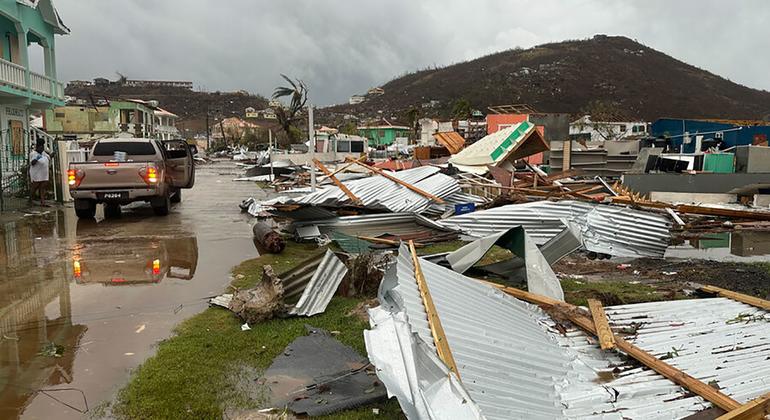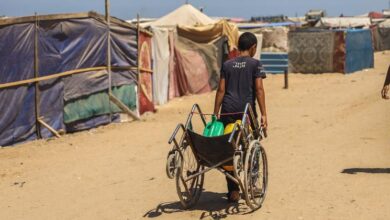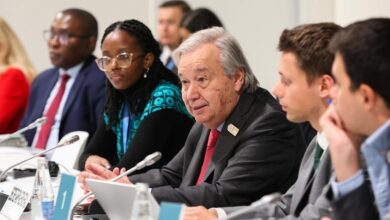UN official describes utter devastation in Carriacou after Storm Beryl

Speaking via video link from Grenada, Simon Springett, the UN Resident Coordinator for Barbados and the Eastern Caribbean, outlined the scene of utter devastation in Carriacou – where Hurricane Beryl first made landfall on July 1.
“The entire island was completely affected… meaning 100 percent of the population.“, he stressed.
Hurricane Beryl is strongest storm It formed in June in the Atlantic Ocean. Initially a tropical depression, it rapidly strengthened into a Category 4 hurricane and briefly reached Category 5, with winds of up to 240 km/h (150 mph).
The storm made landfall on Mexico’s Yucatán Peninsula on Friday morning (New York time) and is said to be moving west-northwest, expected to make landfall in southern Texas, United States on Monday morning.
‘The crisis is very complex’
Mr Springett stressed that the situation was a “very complex crisis”, a crisis marked by serious logistical and access challenges.
Roads on the island were impassable four days after the storm hit and communications were only restored last night, he said.
“Immediately after the storm, rough seas made access there nearly impossible. The air traffic control towers are out of action – so observation is only possible by flying.. But even when the goods are brought to the airport, there is no road to access the goods.”

Union Islanders in Saint Vincent and the Grenadines prepare to board a ferry to take shelter after Hurricane Beryl.
International reaction
Mr Springett said countries near and far were sending aid, including a French ship arriving in Carriacou late in the day along with support from Guyana, Trinidad and Tobago.
“We have a big the explosion of international reaction …it was truly an international effort, and The United Nations is really proud to be a part of this.“, he say.
Also speaking via video link from the Bahamas, Dennis Zulu, Resident Coordinator for Jamaica and the Bahamas, reiterated international cooperation.
He stressed that the United Nations is coordinating with the Caribbean Disaster Emergency Management Agency (CDEMA), the regional disaster and emergency response agency, to ensure a unified response in the region.
“We are preparing to launch a coordinated humanitarian response with the international development partner community and are currently engaging international partners and organisations in Jamaica,” he added.
Widespread damage
Mr Zulu said detailed assessments of the damage in Jamaica and other island nations supported by his office were still underway.
“The damage is very clear and felt by people from all walks of lifeespecially in rural Jamaica, including the southern parishes of Clarendon, Manchester and Saint Elizabeth, and for those living in vulnerable housing,” he added.
He also noted that the Government of Jamaica has put in place an effective response plan, supported by the United Nations and partners, including shelters for those displaced.
In addition, other key requirements include clean drinking water, access to communications, data and livelihood support.

A family stands outside their home destroyed by Hurricane Beryl in Grenada.
‘Committed to being there for children’
According to the United Nations Children’s Fund (UNICEF), more than 650,000 people – including 150,000 children – in Barbados, Grenada, Saint Lucia, Saint Vincent and the Grenadines, and Tobago were in the path of Hurricane Beryl.
Many people have lost their homes and are taking refuge in temporary shelters.
For its part, the UN agency has prepared relief supplies ahead of the storm and is mobilizing supplies and money to respond.
“[We are] very concerned about the plight of those affected by Storm Beryl, especially the most vulnerable – children and women … We are committed to being there for children in affected countries.“, said Pieter Bult, UNICEF Representative for the Eastern Caribbean.
Similarly, the United Nations World Food Programme (World food program) has also deployed teams to affected islands, supporting authorities in assessment and early response.
In Saint Vincent and the Grenadines, the agency has been asked to provide emergency logistics and telecommunications support, while in Barbados, the agency is assisting with emergency food kits that will be transported and distributed to people in affected islands.
‘Very severe’ hurricane season is approaching
Earlier in the day in Geneva, Vanessa Huguenin, spokeswoman for the United Nations Office for the Coordination of Humanitarian Affairs (OCHA), said that while humanitarian organizations are preparing for this hurricane season, “a storm of this magnitude this early in the season is extremely rare.”
“It is also a warning of extremely severe storm season ahead”, she said at a regular press briefing at the United Nations Office at Geneva (UNOG).
The Atlantic hurricane season runs from June to late November, with between 17 and 25 named storms expected. The average is 14 storms a year.
Among them, the World Meteorological Organization of the United Nations (World Meteorological Organization) says there are eight to 13 storms forecast to become hurricanes — above the average of seven — including four to seven major hurricanes.
A major hurricane is a category three, four, or five hurricane on the Saffir Simpson hurricane scale, with winds of 110 mph (177 km/h) or higher.
“This new reality of unprecedented storms is becoming an annual and ever-present reality for Caribbean countries facing the burden of climate change,” said Rhea Pierre, director of disasters at the International Federation of Red Cross and Red Crescent Societies (IFRC).
“The extent of the damage from Hurricane Beryl is clear and devastating.”




